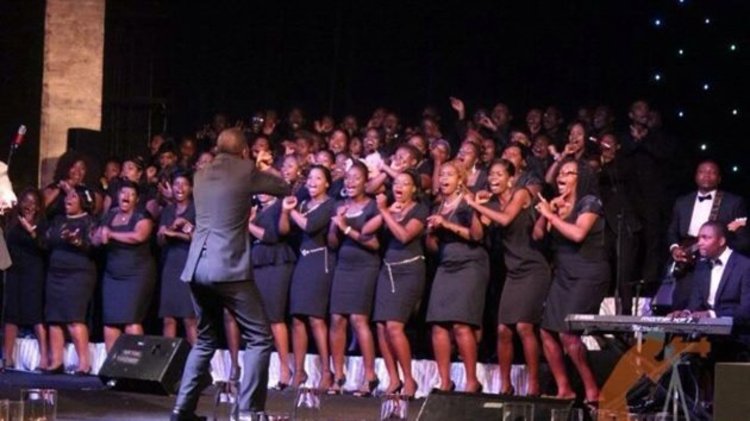Folktales a herigate of knowledge

 Bookshelf Beaven Tapureta —
Bookshelf Beaven Tapureta —
Before the art of writing came about, folktales used to be passed down from generation to generation by word of mouth among the common folk or people who descended from a common ancestor. The stories would be told to young people by a grandmother/father around the fire. There were also itinerant storytellers who moved from one village to another.
Times have changed and what used to be completely an oral art has developed into many various forms. The written form is common.
Although the written tales may not capture the original substance of African orality which includes real song and performance shared between storyteller and audience, they do move with interesting stylistic qualities such as settings in the distant past, magical or miracle performing songs embedded in the plots and the different morality issues expressed through the actions and words of animal and human characters. The written tales still maintain the relationship between the characters and their environment which is paramount in folktales.
One of the important books that have immortalised our sociocultural values which our ancestors founded on experience and wisdom long, long time ago is the Nama award-winning collection of folk stories titled “Around the Fire: Folktales from Zimbabwe” (2014), co-edited by Raisedon Baya and Christopher Mlalazi.
The anthology is blessed with thirteen beautiful tales, long and miniature, tragic and humorous, creatively retold by Zimbabwean writers drawn from diverse cultural backgrounds. The tales reflect the enduring art of storytelling in Africa. These stories are a heritage of knowledge, a reminder to the Zimbabwean folk to go back to their basic social values and do away with foreign influences which have disintegrated the centre that holds our identity and humaneness.
In the anthology, the magic songs or chants are left un-translated, thus capturing the rhythmic vitality of folktale.
Some today’s youth have lost respect for the elderly. Oblivion has become a latest fashion. Yet a whole village realizes that its views about old age and gender are twisted when an old man and an eight year girl save the Chief’s sick son in the tale “The Chief’s Son” by Sibongile Mnkandla. Still on how old people are wrongly perceived, another village in Naison Tfwala’s tale “Nsoyenyoni and Honkwayivas” is clearly shown that the old woman Makhohlomba whom they take as a witch is actually a queen. Her old age and disability are simply a curse or spell under which she was put by an evil monster which “transformed all the people of Buhweland into monsters that looked like itself”. Nature, seeing her suffering, gives her power over an enchanted spring and as the tale unfolds her true queenly, youthful identity is restored.
The tales come with a brilliant demonstration of the animals’ different innate qualities which either save them or put them in danger. Drought and hunger are life-threatening natural disasters against which the animal and human characters fight. Yet in various cases when a character is ‘chosen’ to possess supernatural powers that overcome drought (or any other danger) on behalf of his/her folk, he/she becomes boastful, selfish and eventually loses all.
For instance, in “Sky Black” by Raisedon Baya, a young stock named Sky Black loses his feathers to a certain cunning woman because of his glutton and disrespect for his folk’s values of family togetherness which guarantees safety. In various tales we are shown the protest by animal characters against the plunder of their precious environment by humans.
Where the storytellers in this anthology use animal characters, they do it on purpose, that is, either to ‘explain’ the mythical origin of certain animal physical features as in the tale “Hyena Gets A Zebra Kick” by Thabani H Moyo which ends with the words “from that day, Hyena’s mouth has remained dark and in bad shape due to a Zebra’s kick”. The tales also help to understand the innate skills/talents of the personified animals in order to highlight a moral value.
While the legendary trickster Hare twice outwits Hyena in the tale “Hyena Gets a Zebra Kick”, his prototype in another tale “Hare Meets His Match” (by Bekezela Dube) is a total failure. In Dube’s tale, the animals in the whole jungle dislike Hare who has ‘established himself as the top trickster on the land’. One day, Hare is challenged by Qhude’s gift of ‘upturning his wings and hiding his head right inside under his armpits’, thereby making him (Qhude) look headless yet alive! Qhude’s boasting that he has removed his head and ‘sent it to fetch …some smoke’ fills Hare with jealous. Not wanting to be outdone, he goes home, orders his wife to cut off his head with an axe, hoping he will remain alive to send his head “to do more complex errands than what Qhude could ever dream of”. The lively illustrations are strategically inserted in the tales to blend with the plots without ‘overwhelming’ the text.
“Around the Fire: Folktales from Zimbabwe”, an Intwasa Arts Festival publication, is really an exciting and ‘redemptive’ anthology that encourages us reconsider those cultural foundations which Orature laid down for us. Other tales in the anthology are “Mbijana’s Wife Loses A Leg” by Thabani H Moyo, “Hyenas Don’t Climb Trees” by Nelson Mapako, “Ant Comes to the Rescue” by Tinashe Muchuri, “The Goddess of Kalope Valley” by Nelson Mapako, “Themba Gets Himself An Angel” by Sithandazile Dube, “Jackal Refuses To Stay With Humans” by Thabani H Moyo, “A Meal for Crocodiles” by Raisedon Baya, and “The Mud Crocodile” by Christopher Mlalazi.









Comments